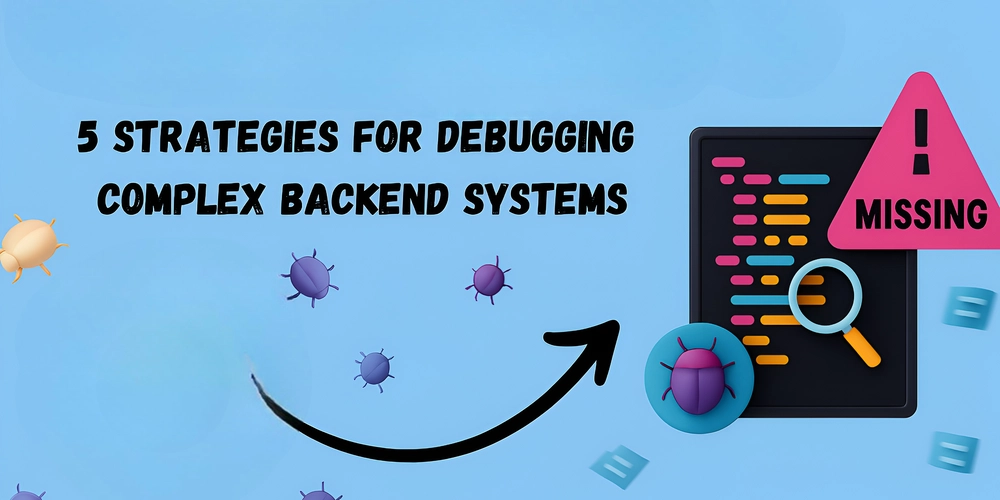Debugging is both an art and a science—especially when it comes to complex backend systems. In my early days, I spent countless hours chasing elusive bugs. Over time, I developed a set of strategies that not only save me time but also improve the overall quality of my code. Here are five key strategies that have made all the difference: 1. Embrace Logging Effective logging is your best friend. Use structured logs: Tools like Winston or Bunyan help you create logs that are easy to search and analyze. Set appropriate log levels: Differentiate between debug, info, warn, and error messages to focus on what matters. Log contextual data: Include request IDs or user identifiers to trace issues across distributed systems. 2. Leverage Automated Testing Prevention is better than cure. Write unit tests: Catch bugs early by testing individual functions. Integrate end-to-end tests: Ensure your entire system works as expected. Utilize Continuous Integration (CI): Automate your testing process to catch regressions quickly. 3. Use Interactive Debuggers Sometimes, you need to step through your code. Node.js Debugger: Use built-in debuggers like node inspect or VS Code’s debugger. Breakpoints and watch variables: These tools let you observe the state of your application in real time, making it easier to pinpoint where things go wrong. 4. Analyze Metrics and Monitoring Monitoring your live system can help identify issues before they become critical. Application Performance Monitoring (APM): Tools like New Relic or Datadog provide insights into performance bottlenecks. Real-time alerts: Set up alerts for unusual patterns, such as spikes in error rates or slow response times. Dashboards: Visualize key metrics to keep track of system health at a glance. 5. Reproduce and Isolate the Issue Understanding the problem is half the battle. Recreate the bug in a controlled environment: Use staging or local environments to replicate the issue. Simplify the code path: Strip down the functionality to isolate the bug. Document your findings: Keeping a record of what you tried can help in debugging similar issues in the future. Final Thoughts Debugging can be challenging, but with the right strategies, it becomes a manageable and even rewarding process. Whether you’re just starting out or have been in the game for years, refining your debugging techniques will always pay off. Your Turn What are your go-to strategies for debugging complex systems? Share your tips and experiences in the comments below!

Debugging is both an art and a science—especially when it comes to complex backend systems. In my early days, I spent countless hours chasing elusive bugs. Over time, I developed a set of strategies that not only save me time but also improve the overall quality of my code. Here are five key strategies that have made all the difference:
1. Embrace Logging
Effective logging is your best friend.
- Use structured logs: Tools like Winston or Bunyan help you create logs that are easy to search and analyze.
- Set appropriate log levels: Differentiate between debug, info, warn, and error messages to focus on what matters.
- Log contextual data: Include request IDs or user identifiers to trace issues across distributed systems.
2. Leverage Automated Testing
Prevention is better than cure.
- Write unit tests: Catch bugs early by testing individual functions.
- Integrate end-to-end tests: Ensure your entire system works as expected.
- Utilize Continuous Integration (CI): Automate your testing process to catch regressions quickly.
3. Use Interactive Debuggers
Sometimes, you need to step through your code.
-
Node.js Debugger: Use built-in debuggers like
node inspector VS Code’s debugger. - Breakpoints and watch variables: These tools let you observe the state of your application in real time, making it easier to pinpoint where things go wrong.
4. Analyze Metrics and Monitoring
Monitoring your live system can help identify issues before they become critical.
- Application Performance Monitoring (APM): Tools like New Relic or Datadog provide insights into performance bottlenecks.
- Real-time alerts: Set up alerts for unusual patterns, such as spikes in error rates or slow response times.
- Dashboards: Visualize key metrics to keep track of system health at a glance.
5. Reproduce and Isolate the Issue
Understanding the problem is half the battle.
- Recreate the bug in a controlled environment: Use staging or local environments to replicate the issue.
- Simplify the code path: Strip down the functionality to isolate the bug.
- Document your findings: Keeping a record of what you tried can help in debugging similar issues in the future.
Final Thoughts
Debugging can be challenging, but with the right strategies, it becomes a manageable and even rewarding process. Whether you’re just starting out or have been in the game for years, refining your debugging techniques will always pay off.
Your Turn
What are your go-to strategies for debugging complex systems? Share your tips and experiences in the comments below!




























![[Webinar] AI Is Already Inside Your SaaS Stack — Learn How to Prevent the Next Silent Breach](https://blogger.googleusercontent.com/img/b/R29vZ2xl/AVvXsEiOWn65wd33dg2uO99NrtKbpYLfcepwOLidQDMls0HXKlA91k6HURluRA4WXgJRAZldEe1VReMQZyyYt1PgnoAn5JPpILsWlXIzmrBSs_TBoyPwO7hZrWouBg2-O3mdeoeSGY-l9_bsZB7vbpKjTSvG93zNytjxgTaMPqo9iq9Z5pGa05CJOs9uXpwHFT4/s1600/ai-cyber.jpg?#)











































































































































![[The AI Show Episode 144]: ChatGPT’s New Memory, Shopify CEO’s Leaked “AI First” Memo, Google Cloud Next Releases, o3 and o4-mini Coming Soon & Llama 4’s Rocky Launch](https://www.marketingaiinstitute.com/hubfs/ep%20144%20cover.png)





























































































































![[FREE EBOOKS] Machine Learning Hero, AI-Assisted Programming for Web and Machine Learning & Four More Best Selling Titles](https://www.javacodegeeks.com/wp-content/uploads/2012/12/jcg-logo.jpg)








































































![Rogue Company Elite tier list of best characters [April 2025]](https://media.pocketgamer.com/artwork/na-33136-1657102075/rogue-company-ios-android-tier-cover.jpg?#)








































































_Andreas_Prott_Alamy.jpg?width=1280&auto=webp&quality=80&disable=upscale#)





























































































![What’s new in Android’s April 2025 Google System Updates [U: 4/18]](https://i0.wp.com/9to5google.com/wp-content/uploads/sites/4/2025/01/google-play-services-3.jpg?resize=1200%2C628&quality=82&strip=all&ssl=1)










![Apple Watch Series 10 Back On Sale for $299! [Lowest Price Ever]](https://www.iclarified.com/images/news/96657/96657/96657-640.jpg)
![EU Postpones Apple App Store Fines Amid Tariff Negotiations [Report]](https://www.iclarified.com/images/news/97068/97068/97068-640.jpg)
![Apple Slips to Fifth in China's Smartphone Market with 9% Decline [Report]](https://www.iclarified.com/images/news/97065/97065/97065-640.jpg)


































































































































